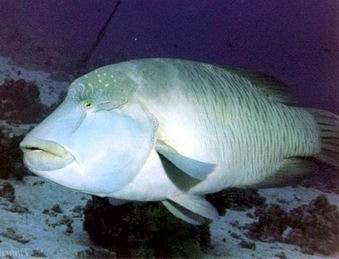|
| 질의: Fishes | 결과: 13080번째/13223 | |
큰양놀래기 (동물이름사전)
| 제목: | 큰양놀래기 (동물이름사전)
| | 올린이: | Administrator (kusnij@naver.com)
| |

| 해상도: 339x259
파일크기: 16827 Bytes
촬영일: 2004:10:05 15:43:20
등록시간: 2004:10:05 16:42:57
|
큰양놀래기 (나폴레옹양놀래기,나폴레옹피시)
학명: Cheilinus undulatus (R??ppell, 1835)
영명: Humphead Wrasse, Napoleon Wrasse, Humphead Maori Wrasse, Napoleon Fish, Truck Wrasse
[분류] 농어목(Perciformes) 놀래기과(Labridae)에 딸린 대형 바다 물고기.
[형태] 몸길이 1.2m까지 자랄만큼 대형으로 놀래기과 물고기중에서는 가장 몸집이 큰 물고기이다. 몸길이 2.29m, 몸무게 190.5kg에 달하는 개체가 포획된 기록이 있다. 머리에는 눈위로 혹이 툭 튀어나와 있는 것이 특징적이며, 성장하면서 혹도 점차 뚜렷하게 자란다. 입술은 두텁다. 빛깔은 암수와 나이에 따라 다양하다. 큰양놀래기는 대개 밝은 청색, 청록색, 녹색, 암청색 등의 색깔을 띤다. 어린 개체와 암컷은 등이 붉은 주황색이고 배는 주황색에서 흰색까지의 빛을 띤다. 수컷은 자라면서 옆면에는 검은색 줄무늬, 각각의 비늘에는 파란색 점, 머리에는 불규칙한 줄무늬가 나타난다.
[생태] 큰양놀래기는 해안가의 얕은 산호초 지대에 서식한다. 서식지의 수심은 대개 2~60m로 낮은 편이다. 어린 큰양놀래기는 얕은 바다의 초호(礁湖)에 살지만 성숙한 개체들은 수심 100m까지의 초호 바닥에 살다가 낮에는 먹이를 구하러 얕은 곳으로 올라온다. 때문에 덩치가 큰 개체들은 가까운 바다보다는 먼 바다에서 발견된다. 독성이 있는 군소류(Sea Hare), 복어(Boxfish), 가시왕관불가사리(Crown-Of-Thorns Starfish) 등을 먹을 수 있는 몇 안되는 포식자이기도 하다.
[먹이] 큰양놀래기의 먹이는 주로 조개와 같은 연체동물, 게, 물고기, 불가사리, 성게 따위이며 바닥에서 먹이를 구하고 강한 이빨로 먹이를 깨 먹는다. 쐐기못 모양의 이빨로 죽은 산호초를 깨트려서 산호에 붙어 서식하는 홍합이나 벌레 따위를 먹기도 한다.
[번식] 암컷은 몸길이 50cm정도가 되면 성적으로 성숙한다. 암컷에서 수컷으로 성전환을 하지만 자세한 것은 알려져 있지 않다. 번식기에는 100여 마리에 이르는 짝짓기 무리를 짓는다. 암수 한쌍이 동시에 산란과 수정을 하며 새끼들은 산호초에 붙어서 자란다.
[수명] 어류중에서는 수명이 매우 길어서 적어도 30년을 사는 것으로 알려져 있으며, 생후 5~7이 되어야 성적으로 성숙한다.
[습성] 큰양놀래기는 낮에는 산호초 근처를 어슬렁거리면서 먹이를 찾고 밤에는 바위틈이나 산호초 밑에서 잠을 잔다. 성숙한 개체는 단독생활을 한다.
[분포] 인도-태평양: 홍해, 동아프리카 연안, 태평양 중앙, 일본, 뉴칼레도니아. 세계 8대 명물 중의 하나인 대보초(Great Barrier Reef)에서 북쪽으로는 파푸아뉴기니, 서쪽으로는 인도-태평양 지역에 이르는 곳에서 서식한다.
[현황] 분포지역은 매우 넓지만 개체수는 매우 작아서 멸종위기에 처해 있으며, 세계야생생물기금(WWF)에서 2004년 9월에 세계 10대 멸종위기 동식물의 하나로 지정하였다. 고기맛이 좋아서 태평양 도서지방 원주민들은 의식에 사용하기도 하며 고급레스토랑용으로 동남아시아 지역으로 수출되기도 한다(고기 1kg에 10만원(미와 100달러)을 넘을 정도로 비싼 어종이라고 한다). 사람을 그리 겁내지 않을 뿐 아니라 호기심이 강해서 어부들에게 쉽게 포획된다. 나폴레옹피시의 가장 큰 시장은 홍콩인데, 이곳에서 거래되는 개체들은 거의가 60cm이하로 아직 어린 고기들이라고 한다. 이로 인해 나폴레옹피시의 개체수가 급감해서 멸종위기에 처하게 되었다. 현재는 세계적인 보호 어종으로 지정되어 호주, 필리핀, 몰디브, 팔라우 등지에서는 보호받고 있다. |
^o^
동물그림창고 똑똑전화 누리집
^o^
|
|